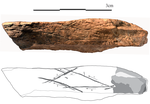
D'ERRICO Francesco
- Unité Mixte de Recherche 5199. De la préhistoire à l'actuel : culture, environnement et anthropologie, CNRS and University of Bordeaux, Pessac, France
- Africa, Archaeometry, Asia, Europe, Middle Palaeolithic, Osseous industry, Raw materials, Rock art, Symbolic behaviours, Traceology, Upper Palaeolithic
- recommender
Recommendations: 0
Review: 1
Review: 1

Experimentation preceding innovation in a MIS5 Pre-Still Bay layer from Diepkloof Rock Shelter (South Africa): emerging technologies and symbols
Experimentation as a driving force for innovation in the Pre-Still Bay from Southern Africa
Recommended by Anne Delagnes based on reviews by Francesco d'Errico, Enza Elena Spinapolice and Kathryn RanhornThe article submitted by Guillaume Porraz et al. [1] shed light on the evolutionary changes recorded during the Pre-Still Bay Lynn stratigraphic unit (SU) from Diepkloof (Southern Africa). It promotes a multi-proxy and integrative approach based on a set of innovative behaviors, such as the engraving of geometric forms, silcrete heat- treatment, the use of adhesive, bladelet and bifacial tools production. This approach is not so common in Middle Stone Age (MSA) studies and makes a lot of sense for discussing the mechanisms that have fostered later innovations during the Still Bay and Howiesons Poort periods. The various innovations that emerge synchronously in this layer contrast with earlier innovations which appear as isolated phenomena in the MSA archaeological record. The strong inventiveness documented in Lynn SU is reported to a phase of experimentation for testing new ideas, new behaviors that would have played a crucial role for the emergence of the Still Bay in a context of socio-economic transformation.
The data presented in this article broadens the scope of two previous articles [2-3] based on a more representative record, collected on an area of 3,5 m² opposed to 2 m² previously, and on the first presentation and description of an engraved bone with a rhomboid pattern. Macro- and microscopic analyses together with the analysis of the distribution of the engraved lines argue convincingly for an intentional engraving. This article constitutes a key contribution to the question of HOW emerged modern cultures in Southern Africa, while calling for further research related to sites’ function, environment and local resources to address the ever-debated question of WHY the MSA groups from Southern Africa developed such unprecedented inventiveness. It makes no doubt that this article deserves recommendation by PCI Archaeology.
[1] Porraz, G., Schmidt, P., Bereiziat, G., Brugal, J.Ph., Dayet, L., Igreja, M., Miller, C.E., Viola, C., Tribolo, C., Val, A., Verna, C., Texier, P.J. 2020. Experimentation preceding innovation in a MIS5 Pre-Still Bay layer from Diepkloof Rock Shelter (South Africa): emerging technologies and symbols. 10.32942/osf.io/ch53r
[2] Porraz, G., Texier, P.J., Archer, W., Piboule, M., Rigaud, J.P, Tribolo, C. 2013. Technological successions in the Middle Stone Age sequence of Diepkloof Rock Shelter, Western Cape, South Africa. Journal of Archaeological Science 40, 3376–3400. 10.1016/j.jas.2013.02.012
[3] Porraz, G., Texier, J.P. Miller, C.E., 2014. Le complexe bifacial Still Bay et ses modalités d’émergence à l’abri Diepkloof (Middle Stone Age, Afrique du Sud). In: XXVIIème Congrès Préhistorique de France, Transitions, Ruptures et Continuité en Préhistoire. Mémoires de la Société Préhistorique Française, 155–175.